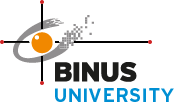CIRCUIT & ELECTRONICS (4/1 Credits)
Learning Outcomes:
On successful completion of this course, students will be able to: explain fundamental concepts of circuits and electronics; solve fundamental concepts of circuits and electronics; experiment using circuits and electronic devices and equipment to draw conclusions; build a practical application using resistor, capacitor, inductor, diode, transistor, op-amp components in a team; Manage acquired knowledge related to circuits and electronics laboratory project; demonstrate good teamwork by showing ethical and professional responsibility.
Topics:
- Introduction : History and overview;
- Relevant tools;
- Engineering standards systems;
- Basic Components and Electric Circuits;
- Voltage and Current Laws;
- Basic Nodal and Mesh Analysis;
- Handy Circuit Analysis Techniques;
- Basic RL, RC and RLC Circuits;
- AC circuit and Power Analysis;
- Semiconductor diode;
- Bipolar Junction Transistor (BJT);
- MOS Transistor;
- MOS Transistor Circuits;
- MOS Transistor Logic Gates;
- Storage Cell;
- Logic Families;
- Operational Amplifier (OpAmp);
- Mixed-signal circuit;
- Handy Circuit Analysis Techniques;
- Semiconductor diode;
- Bipolar Junction Transistor (BJT);
- MOS Transistor Circuits and Logic Gates;
- Logic Family;
- Operational Amplifier;
- L1 – Analysis Method of Electric Circuit;
- L2 – RL, RC, RLC Circuit and Resonance;
- L3 – Diode Model and Characteristic;
- L4 – BJT – Common Emitter Amplifiers;
- L5 – BJT – Common Collector Amplifiers;
- L6 – MOSFET Configuration;
- L7 – Basic OpAmp Circuits 1;
- L8 – Basic OpAmp Circuits 2;
- L9 – Solid State Relay (SSR), H-Bridge, and Active Filters;
- L10 – Laboratory Project 1;
- L11 – Laboratory Project 2;
- L12 – Laboratory Project 3;
- L13 – Laboratory Project 4.



SOCIAL MEDIA
Let’s relentlessly connected and get caught up each other.
Looking for tweets ...